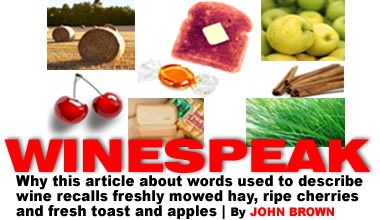John Brown has been a wine and food columnist in West Virginia since the 1980’s. His regular columns appear in the Charleston (WV) Gazette-Mail under the title Vines & Vittles.
Why “ethereal” is out, “orgasmic” is in
As much as I try not to, I sometimes slip into 'winespeak' in describing the hues, smells and tastes of a wine that -- when the adjectives are stripped away -- is either good, OK, or unpleasant. People often ask me why wine writers feel compelled to go to such great lengths and use such “flowery” terms to describe the sensory aspects of wine. My short answer is that wine has such multi-dimensional qualities that it is limiting and not very helpful to use basic terms to describe it. (And besides, most wine writers get paid by the word).
This all came to mind the other day as I was trying to describe the attributes of a particularly good red wine (from the state of Apulia in Italy) known as Salice Salentino. The stuff was so pleasing to me that I was having difficulty describing it without becoming overly exuberant. However, I think there is a difference between using what I will call traditional language to describe wine versus using non-traditional terms. For example, if I describe a riesling as having ripe apple flavors, you will immediately use your own memory of the taste, smell and texture of ripe apples to understand how the wine might actually taste.
If I wanted to be more specific, I could say that particular riesling has the taste of ripe Gala apples. Well, you get the point. In other words, the more specific the language used to describe how the wine looks, tastes and smells is, the better you will be able to make a decision on whether it appeals to you.
On the other hand, if I use non-traditional language to describe the wine, you may end up scratching your head and wondering what “precocious, assertive, or unctuous” have to do with the way a wine smells or tastes. Those are descriptors I try and steer clear of because, first and foremost, they sound like words an officious wine snob might use. And secondly, the terms don’t really provide any good information that can be used to evaluate whether or not I should purchase the wine.
That’s not to say I haven’t ever succumbed to the temptation. The rationalization I once used to defend my description of a particularly good wine ( as being “orgasmic” ) was that most people have some sense of what that word means. Hey, in the interest of propriety, I could have described the experience as having been “ethereal,” but then how many of us have a working knowledge of that transcendent term.
The moral of the story here is that you can benefit from descriptions that are based on solid sensory experiences. In evaluating wine, I have experienced the taste of blackberries, cherries, vanilla, cinnamon, etc.. And I have smelled toast, grass, butterscotch, mold, or limburger cheese. And, besides, it’s fun to sit and sip with friends and describe the plethora of sights, tastes and smells associated with wine. So, back to the 2004 San Marzano Salice Salentino ($11). This wine is bright red in color with aromas of leather, hay and spice. In the mouth, the wine is rich, yet has good balancing acidity, and exhibits flavors of ripe cherries. This is a wine to drink over the next year while the fruit is still fresh. I served the wine with a thin crust pizza I topped with fresh tomatoes, spinach, caramelized onions and buffalo mozzarella. Perfecto!

